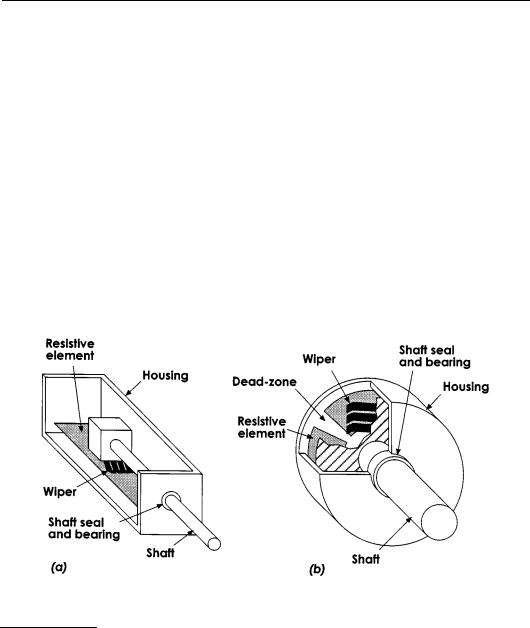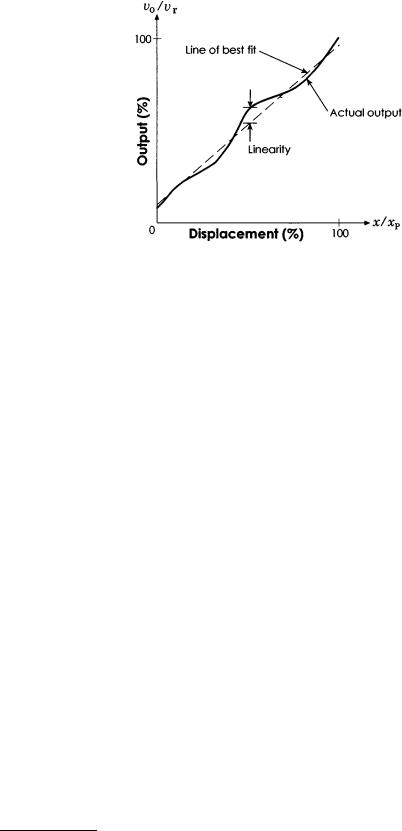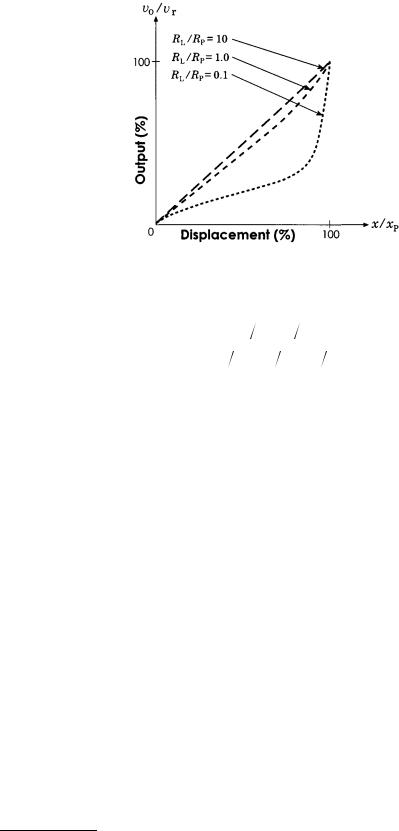
- •6.1 Resistive Displacement Sensors
- •Types of Precision Potentiometers
- •Resistive Element
- •Electrical Characteristics
- •Mechanical Characteristics
- •Mechanical Mounting Methods
- •Implementation
- •6.2 Inductive Displacement Sensors
- •The Single-Coil Linear Variable-Reluctance Sensor
- •The Variable-Differential Reluctance Sensor
- •Variable-Reluctance Tachogenerators
- •Microsyn
- •Synchros
- •Variable-Coupling Transducers
- •Induction Potentiometer
- •Appendix to Section 6.2
- •Variable Distance Displacement Sensors
- •Variable Area Displacement Sensors
- •Variable Dielectric Displacement Sensors
- •Aluminum Type Capacitive Humidity Sensors
- •Tantalum Type Capacitive Humidity Sensors
- •Silicon Type Capacitive Humidity Sensors
- •Polymer Type Capacitive Humidity Sensors
- •Capacitive Moisture Sensors
- •Pulse Width Modulation
- •Square Wave Linearization
- •Feedback Linearization
- •Oscillator Circuits
- •Appendix to Section 6.3
- •6.4 Piezoelectric Transducers and Sensors
- •Single Crystals
- •Piezoelectric Ceramics
- •Perovskites
- •Processing of Piezoelectric Ceramics
- •Piezoelectric Polymers
- •Piezoelectric Ceramic/Polymer Composites
- •Suppliers of Piezoelectric Materials
- •6.5 Laser Interferometer Displacement Sensors
- •Longitudinal Zeeman Effect
- •Two-Frequency Heterodyne Interferometer
- •Single-Mode Homodyne Interferometer
- •6.6 Bore Gaging Displacement Sensors
- •Gages That Control Dimensions
- •Gages That Control Geometry
- •6.7 Time-of-Flight Ultrasonic Displacement Sensors
- •Ultrasound Transducers
- •6.8 Optical Encoder Displacement Sensors
- •Absolute Encoders
- •Incremental Encoders Quadrature Signals
- •Geometric Masking
- •Diffraction-Based Encoders
- •6.9 Magnetic Displacement Sensors
- •6.10 Synchro/Resolver Displacement Sensors
- •Equipment Needed for Testing Resolvers
- •Multispeed Units
- •Applications
- •Resolver-to-Digital Conversion
- •Bandwidth Optimization
- •Encoder Emulation
- •Determining Position Lag Error Due to Acceleration
- •Large Step Settling Time
- •Time Constants
- •6.11 Optical Fiber Displacement Sensors
- •Principle of Operation
- •Fabrication Techniques
- •Bragg Grating Sensors
- •Limitations of Bragg Grating Strain Sensors
- •Principle of Operation
- •Fabrication Procedure
- •Temperature Sensitivity of Long-Period Gratings
- •Knife-Edge Photodetector
- •Bicell Detector
- •Continuous Position Sensor
- •References
Keith Antonelli et al.. "Displacement Measurement, Linear and Angular." Copyright 2000 CRC Press LLC. <http://www.engnetbase.com>.

Keith Antonelli
Kinetic Sciences Inc.
Viktor P. Astakhov
Concordia University
Amit Bandyopadhyay
Rutgers University
Vikram Bhatia
Virginia Tech
Richard O. Claus
Virginia Tech
David Dayton
ILC Data Device Corp.
Halit Eren
Curtin University of Technology
Robert M. Hyatt, Jr.
Howell Electric Motors
Victor F. Janas
Rutgers University
Nils Karlsson
National Defense Research
Establishment
Andrei Kholkine
Rutgers University
James Ko
Kinetic Sciences, Inc.
Wei Ling Kong
Shyan Ku
Kinetic Sciences Inc.
J.R. René Mayer
Ecole Polytechnique de Montreal
David S. Nyce
MTS Systems Corp.
Teklic Ole Pedersen
Linkopings Universitet
© 1999 by CRC Press LLC
Displacement
Measurement,
Linear and Angular
6.1Resistive Displacement Sensors
Precision Potentiometers • Measurement Techniques • Costs and Sources • Evaluation
6.2Inductive Displacement Sensors
Linear and Rotary Variable-Reluctance Transducer • LinearVariable Inductor • Linear Variable-Differential Transformer (LVDT) • Rotary Variable-Differential Transformer • Eddy Current • Shielding and Sensitivity of Inductive Sensors to Electromagnetic Interference • Appendix
6.3Capacitive Sensors—Displacement
Capacitive Displacement Sensors • Differential Capacitive Sensors • Integrated Circuit Smart Capacitive Position Sensors • Capacitive Pressure Sensors • Capacitive Accelerometers and Force Transducers • Capacitive Liquid Level Measurement • Capacitive Humidity and Moisture Sensors • Signal Processing • Appendix
6.4Piezoelectric Transducers and Sensors
Governing Equations and Coefficients • Piezoelectric Materials • Measurements of Piezoelectric Effect • Applications
6.5Laser Interferometer Displacement Sensors
Helium–Neon Laser • Refractive Index of Air • Michelson Interferometer • Conclusions • Appendix
6.6Bore Gaging Displacement Sensors
Bore Tolerancing • Bore Gage Classification and
Specification • GAGE R AND R Standards
6.7Time-of-Flight Ultrasonic Displacement Sensors
Physical Characteristics of Sound Waves • Principles of Time- of-Flight Systems
6.8Optical Encoder Displacement Sensors
Encoder Signals and Processing Circuitry • Encoding
Principles • Components and Technology
6.9Magnetic Displacement Sensors
Magnetic Field Terminology: Defining Terms • Magnetostrictive Sensors • Magnetoresistive Sensors • Hall Effect Sensors • Magnetic Encoders

Ahmad Safari
Rutgers University
Anbo Wang
Virginia Tech
6.10 Synchro/Resolver Displacement Sensors
Induction Potentiometers • Resolvers • Synchros • A Modular Solution • The Sensible Design Alternative for Shaft Angle Encoding • Resolver-to-Digital Converters • Closed Loop Feedback • Type II Servo Loop • Applications
Grover C. Wetsel |
6.11 |
Optical Fiber Displacement Sensors |
||
University of Texas at Dallas |
|
Extrinsic Fabry–Perot Interferometric Sensor • Intrinsic |
||
|
Fabry–Perot Interferometric Sensor • |
Fiber Bragg Grating |
||
|
|
|||
Bernhard Günther Zagar |
|
Sensor • Long-Period Grating Sensor |
• Comparison of |
|
Technical University Graz |
|
Sensing Schemes • Conclusion |
|
|
6.12 |
Optical Beam Deflection Sensing |
|||
|
||||
Theory • Characterization of PSDs • Summary
6.1 Resistive Displacement Sensors
Keith Antonelli, James Ko, and Shyan Ku
Resistive displacement sensors are commonly termed potentiometers or “pots.” A pot is an electromechanical device containing an electrically conductive wiper that slides against a fixed resistive element according to the position or angle of an external shaft. See Figure 6.1. Electrically, the resistive element is “divided” at the point of wiper contact. To measure displacement, a pot is typically wired in a “voltage divider” configuration, as shown in Figure 6.2. The circuit’s output, a function of the wiper’s position, is an analog voltage available for direct use or digitization. Calibration maps the output voltage to units of displacement.
Table 6.1 lists some attributes inherent to pots. This chapter describes the different types of pots available, their electrical and mechanical characteristics, and practical approaches to using them for precision measurement. Sources and typical prices are also discussed. Versatile, inexpensive, and easy- to-use, pots are a popular choice for precision measurement.
Precision Potentiometers
Pots are available in great variety, with specific kinds optimized for specific applications. Position measurement requires a high-quality pot designed for extended operation. Avoid pots classified as trimmers, rheostats, attenuators, volume controls, panel controls, etc. Instead, look for precision potentiometers.
FIGURE 6.1 Representative cutaways of linear-motion (a) and rotary (b) potentiometers.
© 1999 by CRC Press LLC

FIGURE 6.2 (a) Schematic diagrams depict a potentiometer as a resistor with an arrow representing the wiper. This schematic shows a pot used as a variable voltage divider — the preferred configuration for precision measurement. RP is the total resistance of the pot, RL is the load resistance, vr is the reference or supply voltage, and vo is the output voltage. (b) shows an ideal linear output function where x represents the wiper position, and xP is its maximum position.
TABLE 6.1 Fundamental Potentiometer Characteristics
Advantages |
Disadvantages |
|
|
Easy to use |
Limited bandwidth |
Low cost |
Frictional loading |
Nonelectronic |
Inertial loading |
High-amplitude output signal |
Wear |
Proven technology |
|
|
|
Types of Precision Potentiometers
Precision pots are available in rotary, linear-motion, and string pot forms. String pots — also called cable pots, yo-yo pots, cable extension transducers, and draw wire transducers — measure the extended length of a spring-loaded cable. Rotary pots are available with singleor multiturn abilities: commonly 3, 5, or 10 turns. Linear-motion pots are available with maximum strokes ranging from roughly 5 mm to over 4 m [1, 2]. String pots are available with maximum extensions exceeding 50 m [3]. Pot manufacturers usually specify a pot’s type, dimensions, resistive element composition, electrical and mechanical parameters, and mounting method.
Resistive Element
Broadly, a pot’s resistive element can be classified as either wirewound, or nonwirewound. Wirewound elements contain tight coils of resistive wire that quantize measurement in step-like increments. In contrast, nonwirewound elements present a continuous sheet of resistive material capable of essentially unlimited measurement resolution.
Wirewound elements offer excellent temperature stability and high power dissipation abilities. The coils quantize measurement according to wire size and spacing. Providing the resolution limits are acceptable, wirewound elements can be a satisfactory choice for precision measurement; however, conductive plastic or hybrid elements will usually perform better and for considerably more cycles. These and other popular nonwirewound elements are described in more detail below.
Conductive plastic elements feature a smooth film with unlimited resolution, low friction, low noise, and long operational life. They are sensitive to temperature and other environmental factors and their power dissipation abilities are low; however, they are an excellent choice for most precision measurement applications.
© 1999 by CRC Press LLC

TABLE 6.2 Characteristics of Conductive Plastic, Wirewound, and Hybrid Resistive Elements
|
Conductive plastic |
Wirewound |
Hybrid |
|
|
|
|
Resolution |
Infinitesimal |
Quantized |
Infinitesimal |
Power rating |
Low |
High |
Low |
Temperature stability |
Poor |
Excellent |
Very good |
Noise |
Very low |
Low, but degrades with time |
Low |
Life |
106–108 cycles |
105–106 cycles |
106–107 cycles |
TABLE 6.3 Potentiometer Terminal Markings
Terminal |
Possible color codings |
Rotary pot |
Linear-motion pot |
||
|
|
|
|
|
|
1 |
Yellow |
Red |
Black |
CCW limit |
Fully retracted limit |
2 |
Red |
Green |
White |
Wiper |
Wiper |
3 |
Green |
Black |
Red |
CW limit |
Fully extended limit |
|
|
|
|
|
|
Hybrid elements feature a wirewound core with a conductive plastic coating, combining wirewound and conductive plastic technologies to realize some of the more desirable attributes of both. The plastic limits power dissipation abilities in exchange for low noise, long life, and unlimited resolution. Like wirewounds, hybrids offer excellent temperature stability. They make an excellent choice for precision measurement.
Cermet elements, made from a ceramic-metal alloy, offer unlimited resolution and reasonable noise levels. Their advantages include high power dissipation abilities and excellent stability in adverse conditions. Cermet elements are rarely applied to precision measurement because conductive plastic elements offer lower noise, lower friction, and longer life.
Carbon composition elements, molded under pressure from a carbon–plastic mixture, are inexpensive and very popular for general use, but not for precision measurement. They offer unlimited resolution and low noise, but are sensitive to environmental stresses (e.g., temperature, humidity) and are subject to wear.
Table 6.2 summarizes the distinguishing characteristics of the preferred resistive elements for precision measurement.
Electrical Characteristics
Before selecting a pot and integrating it into a measurement system, the following electrical characteristics should be considered.
Terminals and Taps
Table 6.3 shows the conventional markings found on the pot housing [4, 5]; CW and CCW indicate clockwise and counter-clockwise rotation as seen from the front end. Soldering studs and eyelets, integral connectors, and flying leads are common means for electrical connection. In addition to the wiper and end terminals, a pot may possess one or more terminals for taps. A tap enables an electrical connection to be made with a particular point along the resistive element. Sometimes, a shunt resistor is connected to a tap in order to modify the output function. End terminations and taps can exhibit different electrical characteristics depending on how they are manufactured. See [2] for more details.
Taper
Pots are available in a variety of different tapers that determine the shape of the output function. With a linear-taper pot, the output varies linearly with wiper motion, as shown in Figure 6.2. (Note that a pot with a linear taper should not be confused with a linear-motion pot, which is sometimes called a “linear pot.”) Linear-taper pots are the most commonly available, and are widely used in sensing and control
© 1999 by CRC Press LLC

FIGURE 6.3 Independent linearity is the maximum amount by which the actual output function deviates from a line of best fit.
applications. Pots with nonlinear tapers (e.g., logarithmic, sine, cosine, tangent, square, cube) can also be useful, especially where computer control is not involved. Nonstandard tapers can be custom-manu- factured or alternatively, certain types of output functions can be produced using shunt resistors, by combining outputs from ganged pots or by other means. (Refer to [6, 7] for more details.) Of course, if a computer is involved, the output function can always be altered through a software lookup table or mapping function.
Electrical Travel
Figure 6.2 shows how the ideal output of a pot changes with wiper position. In practice, there is a small region at both ends where output remains constant until the wiper hits a mechanical stop. Mechanical travel is the total motion range of the wiper, and electrical travel is the slightly smaller motion range over which the electrical output is “valid.” Thus, when using a pot as a sensor, it is important to ensure that the wiper motion falls within the electrical travel limits.
Linearity
Linearity is the maximum deviation of the output function from an ideal straight line. Independent linearity is commonly specified, where the straight line is defined as the line that minimizes the linearity error over a series of sampled points, not necessarily measured over the full range of the pot. See Figure 6.3. Other linearity metrics, such as terminal-based linearity, absolute linearity, and zero-based linearity, are also sometimes used. Refer to [8] for more details. Pots are commonly available with independent linearities ranging from under 0.1% to 1%. When dealing with nonlinear output functions, conformity is specified since it is the more general term used to describe deviation from any ideal function. Conformity and linearity are usually expressed as a percentage of full-scale output (FSO).
Electrical Loading
Loading can significantly affect the linearity of measurements, regardless of a pot’s quality and construction. Consider an ideal linear pot connected to an infinite load impedance (i.e., as in Figure 6.2). Since no current flows through the load, the output changes perfectly linearly as the wiper travels along the length of the pot. However, if the load impedance is finite, the load draws some current, thereby affecting the output as illustrated in Figure 6.4. Circuit analysis shows that:
© 1999 by CRC Press LLC

FIGURE 6.4 Linearity can be greatly influenced by the ratio of load resistance, RL, to potentiometer resistance, RP.
v |
o |
= |
|
(x xP )(RL RP ) |
|
|
(6.1) |
||||
vr |
(R |
R |
)+ (x x |
P |
)− |
(x x |
P |
)2 |
|||
|
|
|
L |
P |
|
|
|
|
|
||
Therefore, RL/RP should be maximized to reduce loading effects (this also involves other trade-offs, to be discussed). A minimum RL/RP value of 10 is sometimes used as a guideline since loading error is then limited to under 1% of full-scale output. Also, some manufacturers recommend a minimum load impedance or maximum wiper current in order to minimize loading effects and prevent damage to the wiper contacts. The following are some additional strategies that can be taken:
•Use a regulated voltage source whose output is stable with load variations
•Use high input-impedance signal conditioning or data acquisition circuitry
•Use only a portion of the pot’s full travel
Resolution
Resolution defines the smallest possible change in output that can be produced and detected. In wirewound pots, the motion of the wiper over the coil generates a quantized response. Therefore, the best attainable resolution is r = (1/N) × 100%, where N is the number of turns in the coil. Nonwirewound pots produce a smooth response with essentially unlimited resolution. Hybrid pots also fall into this category. In practice, resolution is always limited by factors such as:
•Electrical noise, usually specified as noise for wirewound pots and smoothness for nonwirewound pots, both expressed as a percentage of full-scale output [10]
•Stability of the voltage supply, which can introduce additional noise into the measurement signal
•Analog-to-digital converter (ADC) resolution, usually expressed in “bits” (e.g., 10 mm travel digitized using a 12-bit ADC results in 10 mm/4096 = 0.0024 mm resolution at best)
•Mechanical effects such as stiction
Power Rating
The power dissipated by a pot is P = vr2/RP . Therefore, power rating determines the maximum voltage that can be applied to the pot at a given temperature. With greater voltage supplied to the pot, greater
© 1999 by CRC Press LLC
